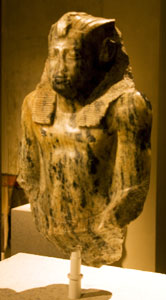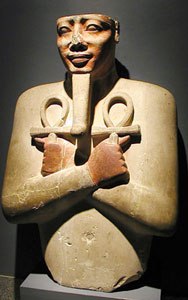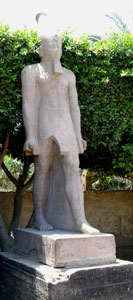
Senusret I Kheperkare (also known as Sesostris I and Senwosret I) was the second pharaoh of the Twelfth Dynasty (Middle Kingdom) of Ancient Egypt. The Turin Canon confirms that he ruled Egypt for forty-five years.
He was the son of Amenemhat I and his wife was Nefertitanen, and it is generally considered that Amenemhat I made Senusret his co-regent (possibly around the twentieth year of his reign). However, Obsomer has questioned whether there was in fact any co-regency.
It is notable that the text of “the Instructions of King Amenemhat for his son Senusret” suggests that the succession had not been legitimised before Amenemhat was assassinated. This text was probably composed by Khety on the orders of Senusret in order to confirm his position and eulogise his father. Hornung suggests it may have been the inaugural address of Senusret and Callendar notes that it would have served as a useful excuse to allow him to take punitive measures against his opponents.

In this text the ghost of Amenemhat states;
“bloodshed occurred while I was without you; before the courtiers had heard I would hand over to you; before I had sat with you so as to advise you. For I had not prepared for it, had not expected it, had not foreseen the failing of the servants.”
The assassination of Amenemhat is also referred to in The Story of Sinuhe which confirms that Senusret was on an expedition to fight Libyans when his father was murdered and had to return home at haste without even notifying his army that he was leaving! This has been taken by some as evidence that he needed to get back to ensure his accession before the plotters placed another on the throne (which would have been harder to do if Senusret was already co-regent, but not impossible).

Once Senusret had taken his place as sole ruler of Egypt, he carried on the work of his father in expanding the borders of Egypt to the south. He stationed a garrison in the fort at Buhen and established a victory stele nearby. His generals pushed as far as the second cataract, stamping the authority of Egypt on Nubia. This control was maintained by at least thirteen forts and numerous troops. He was worshipped in Nubia as a divine being for some time after his reign. Senusret also sent expeditions to the Western Desert and into Asia to secure the western and eastern borders of Egypt.

Senusret constructed an alabaster kiosk for the cult statue of Amun at Karnak, known as the White Chapel. Despite its diminutive size, it is distinguished by the artistry of its decoration. He refurbished the temple of Re at Heliopolis establishing two huge granite obelisks (one of which still stands) for the celebration of his Sed festival. He rebuilt the temple of Osiris Khentiamentiu at Abydos and the celebration of his resurrection reached new heights, as his officials placed numerous stele along the route of the annual procession.

His program of temple building and refurbishment encompassed each of the main cult sites of the major deities of Egypt. This ensured that the people would see Senusret as a pious ruler whose will was one with the gods, but also allowed him to reduce the power of local nomarchs in their provinces by reaffirming his role as the connection between the people of Egypt and their gods. It also enabled him to leave a permanent record of his rule which he hoped would stand for eternity. In a building text the king remarked;
“My excellence will be remembered…the shrine is my name, the lake is my memorial…A King who is evoked by his works is not doomed. He who plans for himself does not know oblivion for his name is still pronounced for it”.

His reign was generally characterised by great wealth and prosperity. Senusret sent numerous expeditions to Wadi Hammamat, Sinai, Hatnub, and Wadi el-Hudi and established trading links with Syrian cities to ensure that Egypt had access to a wide array of raw materials, gems, and luxuries.
The artistic achievements of his reign are exemplified by the exquisite jewellery recovered from the tombs of the royal ladies at Dahshur and Lahun. However, even during such a time of peace and plenty there are references to famine and hardship from sources such as the “Heqanakht papyri” and in tomb inscriptions at Beni Hassan.

His chief wife was Neferu and their son Amenemhat served as his co-regent towards the end of his reign. Amenemhat went on to rule as Amenemhat II Nubkare.
Senusret was buried in his pyramid at Lisht close to that of his father. Nine satellite pyramids within his complex are thought to have contained the burials of his female relatives including his wife Neferu and his daughters Itekuyet, Nefru-Sobek, Nefreu-Ptah, and Nenseddjedet. The identities of the other tomb-owners are unclear.
Pharaoh’s Names
- Manetho; Ammenemes
- Horus Name: Ankhmesut (Horus, Living Of Births)
- Kheperkare (The Ka Of Re Has Come Into Being)
- Senusret (Man From Weseret; Man Of Goddess Wosret)
Bibliography
- Bard, Kathryn (2008) An introduction to the Archaeology of Ancient Egypt
- Callender G (2003) “The Middle Kingdom Renaissance” in Oxford History of Ancient Egypt. Edited by I Shaw
- Dodson, A and Hilton, D. (2004) The Complete Royal Families of Ancient Egypt
- Hornung E (1999) History of Ancient Egypt
- Kemp B.J. (1991) Ancient Egypt: anatomy of a civilization
- Rice M. (1999) Who’s Who in Ancient Egypt
- Lichtheim M.(2006) Ancient Egyptian Literature, Volume I
- Van de Mieroop M.(2010) A History of Ancient Egypt
Copyright J Hill 2010